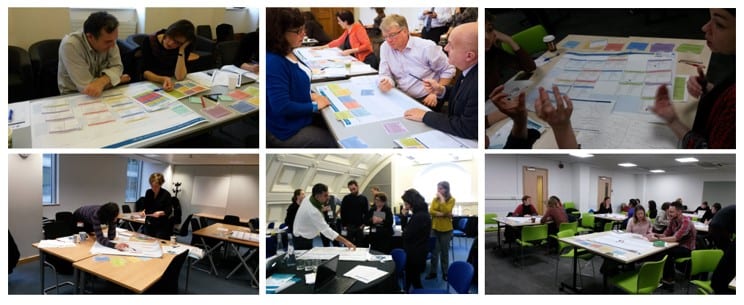ABC has reached 21
By Natasa Perovic, on 24 March 2016
(For latest news about ABC LD, visit ABC LD blog)
Digital Education has now run 21 of our popular rapid learning design workshops. ABC uses an effective and engaging paper card-based method in a 90 minute hands-on workshop. It is based on research from the JISC and UCL IoE and over the last year has helped 70 module and course teams design and sequence engaging learning activities. It has proved particularly useful for new programmes or those changing to an online or more blended format.
To find out if ABC is for you this short video captured one of our workshops earlier this year.
Participants feedback remains encouragingly positive
“I thought the ABC session was really helpful. I had been a little unsure ahead of the session what it would achieve – but I genuinely got a lot from it. Going back to the basics of methods etc really helped focus on the structure and balance of the module. I thought the output was very useful.”
“Thank you for convening the abc workshop today, i found it thought provoking and challenged the way we think about our teaching. It is too easy to stick to what we have done previously and I found today gave me different ways to think about how to evaluate our current teaching and to bring in different approaches. It will definitely improve my thinking and I will continue with the approach to incorporate some of the ideas into the modules.”
“Thank you for the workshop today- it was an eye opener. I found it really useful to think about categorising how the learning objectives will be delivered and assessed, and examining the variety of ways that these can be achieved. It made me think more deeply about what skills the students can develop by making them responsible for their learning journey and not simply the content that needs to be delivered to them. We will let you know how it goes!”
“It was great and many initiatives have emerged from it.”
For questions and workshops contact Clive and Nataša
For more information see :
ABC Curriculum Design 2015 Summary
https://blogs.ucl.ac.uk/digital-education/2015/12/02/abc-curriculum-design-2015-summary/
ABC workshop resources and participants’ feedback https://blogs.ucl.ac.uk/digital-education/2015/09/30/9169/
ABC beginnings https://blogs.ucl.ac.uk/digital-education/2015/04/09/abc-arena-blended-connected-curriculum-design/
ABC News:
We are currently developing an online toolkit to support the workshop, have been working closely with CALT to embed the Connected Curriculum in designs and we are developing collaboration projects with The University of Glasgow, Aarhus University (Denmark), University of Leiden (Netherland) and Universidad Adolfo Ibáñez (Chile) in order to look at the learning impact of this method. Our colleagues in Chile are even translating the workshop into Spanish.
ABC also featured on UCL Teaching and Learning portal as a case study: Designing programmes and modules with ABC curriculum design http://www.ucl.ac.uk/teaching-learning/case-studies-news/e-learning/designing-abc-curriculum-design
 Close
Close








